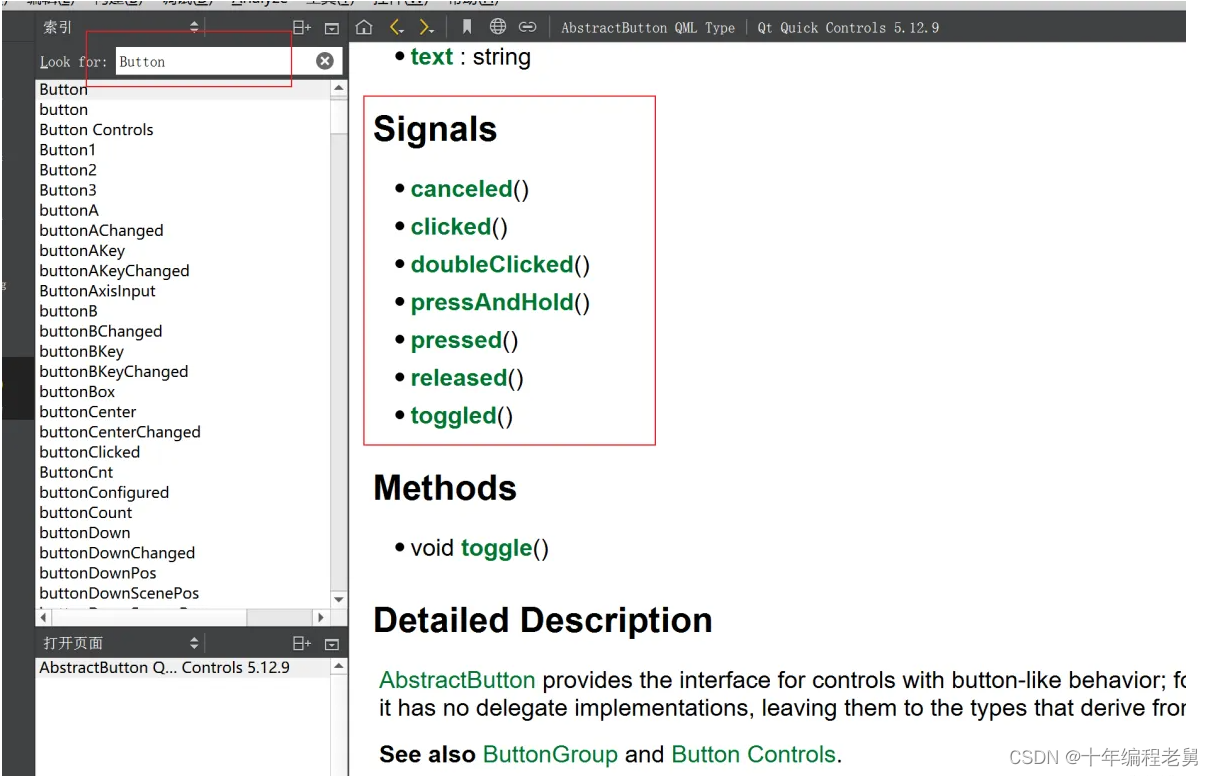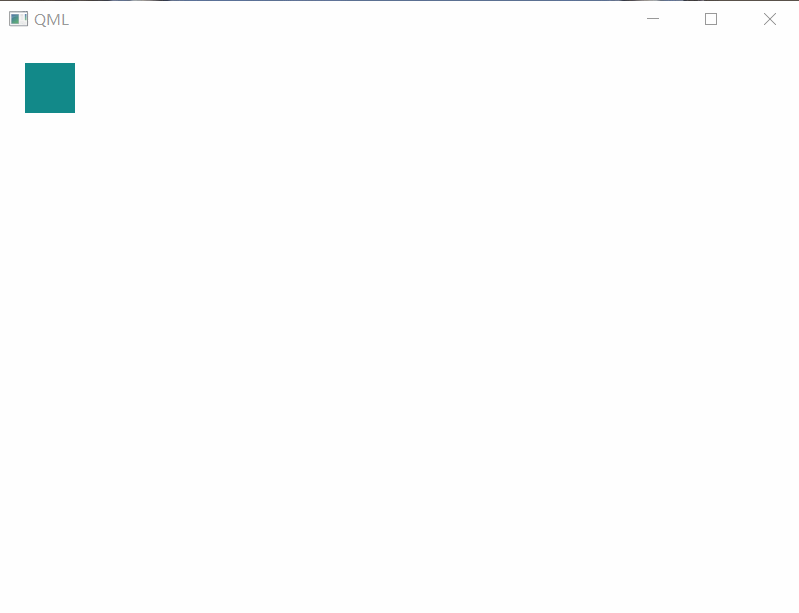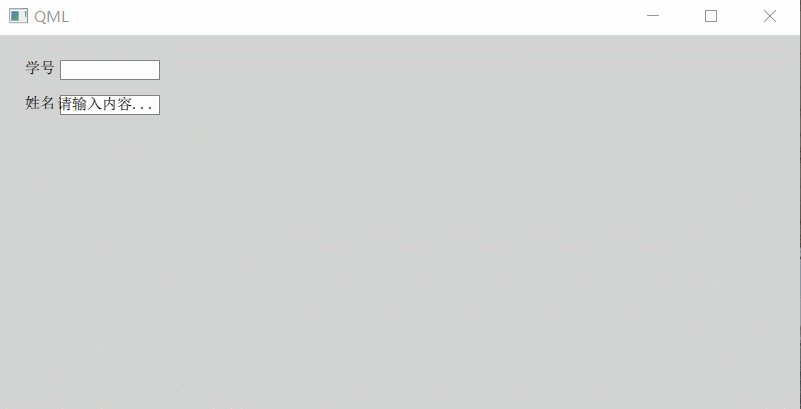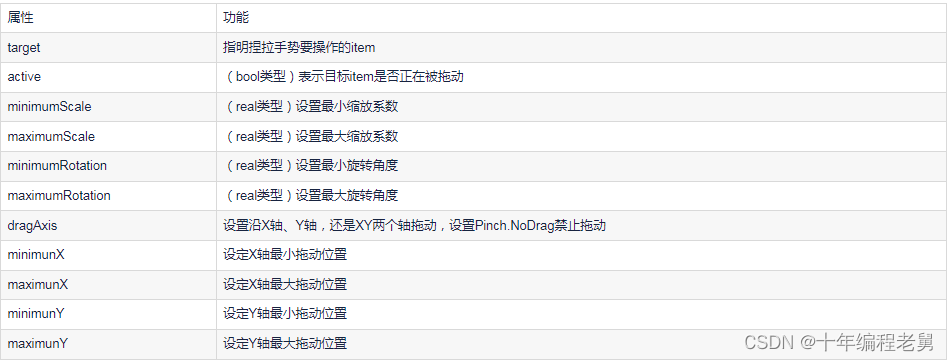一、信号处理器
import QtQuick 2.2
import QtQuick.Contrils 1.2
Rectangle {
width: 320;
height: 240;
color: "gray";
Button {
text: "Quit";
anchors.centerIn: parent;
onClicked: { //a
Qt.quit(); //b
}
}
}信号处理器,其实等价于Qt中的槽,上述代码中a处就是一个信号处理器,可以看到它是大括号包围起来的代码块,可以将其理解为匿名函数。
信号处理器一般是on<Signal>这种形式(信号首字母大写),上述代码中a处,Button对象有信号:clicked(),所以其对应的信号处理器为onClicked: {}。
上述代码b处,Qt对象是Qt Quick导出到QML环境中的对象,它的quit()方法用于退出应用。
本文福利,莬费领取Qt开发学习资料包、技术视频,内容包括(C++语言基础,C++设计模式,Qt编程入门,QT信号与槽机制,QT界面开发-图像绘制,QT网络,QT数据库编程,QT项目实战,QSS,OpenCV,Quick模块,面试题等等)↓↓↓↓↓↓见下面↓↓文章底部点击莬费领取↓↓
二、附加信号处理器
信号处理器放在拥有信号的元素内部,当元素信号发射时,处理器被调用;如果要处理的信号不是当前元素发出来的,而是其它类型(对象),比如Keys,这就是附加信号处理器。
在QML语法中,有一个附加属性和附加信号处理器的概念,这是附加到一个对象上的额外的属性。
从本质上来讲,这些属性是由附加类型来实现和提供的,它们可能被附加到另一种类型的对象上。
附加属性与普通属性的区别在于,对象的属性普遍是由对象本身或其基类(或沿继承层级向上追溯的祖先)提供的。
import QtQuick 2.2
item {
width: 100;
height: 100;
focus: true;
Keys.enabled: false;
Keys.onReturnPressed: console.log("Return key was pressed");
}上述代码中,enable是Keys对象的一个属性,onReturnPressed是Keys对象的returnPressed信号的附加信号处理器,returnPressed信号是Keys对象发出来的,不是item对象发出来的,所以onReturnPressed: {}就是附加信号处理器。
对于附加信号处理器,和普通信号处理器有所不同。普通信号处理器,你只要知道信号名字,然后按照on<Signal>语法来定义信号处理器的名字即可;而附加信号处理器,则要遵循<AttachingType>.on<Signal>语法。
Component对象也有一些附加信号,如complated()、destruction(),可以用来在Component创建完成或销毁时执行一些JS代码来做初始化或反初始化相关的工作,例如:
Rectangle { Component.onCompleted: console.log("Completed!"); Component.onDestruction: console.log(Destruction!); }三、Connections
信号处理器与附加信号处理器有一个共性:响应信号的代码都放在元素内部,通过JS代码块就地实现,Qt Quick还有另一种方式来处理信号与槽,那就是:专业的Connections
使用信号处理器处理QML信号,都是用on<Signal>这种就地代码块的方式,而在有些情况下,这样的处理并不方便,例如:
你需要将多个对象连接到同一个QML信号上;
你需要在发出信号的对象的作用域之外来建立连接;
发射信号的对象没有在QML中定义(可能是通过C++导出的)
Connections有一个属性:target,它指向发出信号的对象。
Connections {
target: area;
on<Signal>: function or code block;
}实例:界面防止两个文本,一个按钮,每点击按钮一次,两个文本对象都变颜色,而他们的颜色是随机的
import QtQuick 2.2
import QtQuick.Controls 2.0
Rectangle {
width: 320;
height: 240;
color: "gray";
Text {
id: text1;
anchors.horizontalCenter: parent.horizontalCenter;
anchors.top: parent.top;
anchors.topMargin: 20;
text: qsTr("text one");
color: "blue";
font.pixelSize: 28;
}
Text {
id: text2;
anchors.horizontalCenter: parent.horizontalCenter;
anchors.top: text1.bottom;
anchors.topMargin: 8;
text: qsTr("text two");
color: "blue";
font.pixelSize: 28;
}
Button {
id: changeButton;
anchors.top: text2.bottom;
anchors.topMargin: 8;
anchors.horizontalCenter: parent.horizontalCenter;
text: "Change";
}
Connections {
target: changeButton;
onClicked: {
text1.color = Qt.rgba(Math.random(),Math.random(),Math.random(),1);
text2.color = Qt.rgba(Math.random(),Math.random(),Math.random(),1);
}
}
}四、信号查询
(1)Qt帮助文档
例如Button,检索Button,沿层级继承关系向上索引

Qt帮助中说,属性变化是会自动发出一个信号,形如<property>Changed,它对应的信号处理器形如on<Property>Changed,比如Text元素有一个text属性,你可以写一个名为onTextChanged的信号处理器,但是不见得每个属性都好使,需要自己仔细测试。
(2)从Qt Quick头文件查看属性相关的信号
Qt Quick中你看到的很多对象,都是在Qt C++中实现,然后导入到QML环境中的。所以,如果你关心那些被文档隐藏了的信号,你可以这么做:
找到QML类型对象的C++类型;
找到C++类型的头文件,查看属性声明来确认是否有信号与属性关联;
使用Component.onCompleted附加信号,在附加信号处理器中输出类型信息,例如:
import QtQuick 2.2
import QtQuick.Controls 2.0
Rectangle {
width: 320;
height: 240;
color: "gray";
Text {
id: text1;
anchors.centerIn: parent;
text: qsTr("Hello World");
color: "blue";
font.pixelSize: 32;
}
Button {
id: button1;
text: "A Button";
anchors.top: text1.bottom;
anchors.topMargin: 4;
}
Image {
id: image1;
}
Component.onCompleted: {
console.log("QML Text\'s C++ type - ", text1);
console.log("QML Button\'s C++ type - ", button1);
console.log("QML Image\'s C++ type - ", image1);
}
}
知道了QML Text对应的C++类型是QQuickText,就可以去安装路径中寻找类文件(安装路径不同,路径会有差异,根据自身情况而定)
C:\Qt\Qt5.12.9\5.12.9\mingw73_64\include\QtQuick\5.12.9\QtQuick\private

五、自定义信号
如果自己定义新的QML类型,可以使用signal关键字给你的类型添加信号,语法如下:
signal <name>[([<type> <parameter name>[,...]])]信号其实就是个方法(函数),所以它的发射实际是通过以信号名为名的方法达成的。
实例:界面上放一个字符串、两个代表颜色的小方块,点方块,字符串的颜色就变成小方块的颜色
import QtQuick 2.2
Rectangle {
width: 320;
height: 240;
color: "#C0C0C0";
Text {
id: coloredText;
anchors.horizontalCenter: parent.horizontalCenter;
anchors.top: parent.top;
anchors.topMargin: 4;
text: qsTr("Hello World");
font.pixelSize: 32;
}
Component {
id: colorComponent;
Rectangle {
id: colorPicker;
width: 50;
height: 30;
signal colorPicked(color clr);
MouseArea {
anchors.fill: parent;
onPressed: colorPicker.colorPicked(colorPicker.color);
}
}
}
Loader {
id: redLoader;
anchors.left: parent.left;
anchors.leftMargin: 4;
anchors.bottom: parent.bottom;
anchors.bottomMargin: 4;
sourceComponent: colorComponent;
onLoaded: {
item.color = "red";
}
}
Loader {
id: blueLoader;
anchors.left: redLoader.right;
anchors.leftMargin: 4;
anchors.bottom: parent.bottom;
anchors.bottomMargin: 4;
sourceComponent: colorComponent;
onLoaded: {
item.color = "blue";
}
}
Connections {
target: redLoader.item;
onColorPicked: {
coloredText.color = clr;
}
}
Connections {
target: blueLoader.item;
onColorPicked: {
coloredText.color = clr;
}
}
}Component定义了一个组件,组件内定义了一个Rectangle对象,定义了信号colorPicked;
在Rectangle对象中的鼠标区域(MouseArea)的onPressed信号处理器中调用了信号,所以信号的触发就是一个函数调用;
组件是可以重复利用的,一个组件可以在一个单独的QML文件中定义,也可以嵌入到其它QML文档中来定义,以方便简单组件的使用;
定义好了组件,就可以使用Loader来加载组件;
Loader是专门用来动态创建组件的,它可以从QML文件中创建组件,也可以指定sourceComponent来创建;
Loader中的onLoader事件处理器中的item,实际就是它Loader创建的对象(colorComponent);
使用Connections来建立信号的连接,target指向Loader对象的item属性,因为item是指向colorComponent,所以可以使用onColorPicked信号处理器(自定义的信号);
因为定义的信号带有名为clr的参数,所以Connections的信号处理器可以直接使用clr来给coloredText对象的color属性赋值;
本文福利,莬费领取Qt开发学习资料包、技术视频,内容包括(C++语言基础,C++设计模式,Qt编程入门,QT信号与槽机制,QT界面开发-图像绘制,QT网络,QT数据库编程,QT项目实战,QSS,OpenCV,Quick模块,面试题等等)↓↓↓↓↓↓见下面↓↓文章底部点击莬费领取↓↓
六、信号与槽的连接
前面我们使用信号时,要么通过信号处理器,要么使用Connections对象。其实在QML中还有一种更一般的方式,在QML中,其实signal是个对象,它也有一个connect()方法,可以使用它连接到任意的方法上,有connect()和disconnect();
signal对象的connect()方法允许你连接一个信号到另外一个信号或者方法。当信号发射时,连接到信号上的其它信号或者方法会被调用;
signal对象的这种连接方式,使用起来比信号处理器更加灵活,信号处理器与信号是一对一的关系,而signal对象的这种连接方式,使得一个信号能够连接多个方法;
信号连接方法示例
import QtQuick 2.2
Rectangle {
id: relay;
signal messageReceived(string person, string notice);
Component.onCompleted: {
relay.messageReceived.connect(sengToPost);
relay.messageReceived.connect(sengToTelegraph);
relay.messageReceived.connect(sengToEmail);
}
function sengToPost(person, notice) {
console.log("Sending to post: " + person + ", " + notice);
}
function sengToTelegraph(person, notice) {
console.log("Sending to telegraph: " + person + ", " + notice);
}
function sengToEmail(person, notice) {
console.log("Sending to email: " + person + ", " + notice);
}
}信号连接信号示例
import QtQuick 2.2
Rectangle {
id: forwarder;
signal send();
onSend: {
console.log("Send clicked");
}
MouseArea {
id: mousearea;
anchors.fill: parent;
onClicked: {
console.log("MouseArea clicked");
}
}
Component.onCompleted: {
mousearea.clicked.connect(send);
}
}我们给Rectangle定义了一个信号send(),在Component.onCompleted附加信号处理器中,吧MouseArea对象的clicked信号连接到了Rectangle的send()信号上;
七、鼠标事件
与以前的窗口部件不同,在QML中如果一个元素想要处理鼠标事件,则要在其上放置一个MouseArea元素,也就是说,用户只能在MouseArea确定的范围内进行鼠标的动作。
(1)Rect.qml
import QtQuick 2.0
Rectangle {
width: 50; height: 50
color: "teal"
MouseArea {
anchors.fill: parent
/*拖拽属性设置*/ //(a)
drag.target: parent
drag.axis: Drag.XAxis
drag.minimumX: 0
drag.maximumX: 360 - parent.width
acceptedButtons: Qt.LeftButton | Qt.RightButton //(b)
onClicked: {
if(mouse.button === Qt.RightButton){ //(c)
parent.color = "blue"
parent.width -= 5
parent.height -= 5
}else if((mouse.button === Qt.LeftButton)&&(mouse.modifiers & Qt.ShiftModifier)) { //(d)
parent.color = "teal"
parent.width = 50
parent.height = 50
}else {
parent.color = "green"
parent.width += 5
parent.he += 5
}
}
}
}(a)拖拽属性设置:MouseArea中的drag分组属性提供了一个使元素可被拖拽的简便方法。drag.target属性用来指定被拖拽的元素的id(这里为parent表示被拖拽的就是所在元素本身);drag.active属性获取元素当前是否正在被拖拽的信息;drag.axis属性用来指定拖拽的方向,可以是水平方向(Drag.XAxis)、垂直方向(Drag.YAxis)或者两个方向都可以(Drag.XandYAxis);drag.minimumX和drag.maximumX限制了元素在指定方向上被拖拽的范围。
(b)acceptedButtons:Qt.LeftButton | Qt.RightButton:MouseArea所能接受的鼠标按键,可取的值有Qt.LeftButton(鼠标左键)、Qt.RightButton(鼠标右键)和Qt.MiddleButton(鼠标中键)。
(c)mouse.button:为MouseArea信号中所包含的鼠标事件参数,其中mouse为鼠标事件对象,可以通过它的x和y属性获取鼠标当前的位置;通过button属性获取按下的按键。
(d)mouse.modigiers & Qt.ShiftModifier:通过modifiers属性可以获取按下的键盘修饰符,modifiers的值由多个按键进行位组合而成,在使用时需要将modifiers与这些特殊的按键进行按位与来判断按键,常用的按键有Qt.NoModifier(没有修饰键)、Qt.ShiftModifier(一个Shift键)、Qt.ControlModifier(一个Ctrl键)、Qt.AltModifier(一个Alt键)。
(2)MainForm.qml
import QtQuick 2.7
Rectangle {
width: 360; height: 360
property alias mouseArea: mouseArea
MouseArea {
id: mouseArea
anchors.fill: parent
}
Rect {
x: 25; y: 25
opacity: (360.0 - x)/360
}
}
(3)运行效果

八、键盘事件
当一个按键按下或释放时,会产生一个键盘事件,并将其传递给获得了焦点的QML元素。在QML中,Keys属性提供了基本的键盘事件处理器,所有可视化元素都可以通过它来进行按键处理。
(1)MainForm.qml
import QtQuick 2.7
Rectangle {
width: 360; height: 360
property alias mouseArea: mouseArea
MouseArea {
id: mouseArea
anchors.fill: parent
}
Row {
x: 50; y: 50
spacing: 30
Rectangle {
id: music
width: 100; height: 100
radius: 6
color: focus ? "red" : "lightgray"
scale: focus ? 1 : 0.8
focus: true
KeyNavigation.tab: play //(a)
/*移动图标位置*/ //(b)
Keys.onUpPressed: music.y -= 10
Keys.onDownPressed: music.y += 10
Keys.onLeftPressed: music.x -= 10
Keys.onRightPressed: music.x += 10
Text {
anchors.centerIn: parent
color: parent.focus ? "black" : "gray"
font.pixelSize: 20
text: "音乐"
}
}
Rectangle {
id: play
width: 100; height: 100
radius: 6
color: focus ? "green" : "lightgray"
scale: focus ? 1 : 0.8
KeyNavigation.tab: movie
/*移动图标位置*/
Keys.onUpPressed: play.y -= 10
Keys.onDownPressed: play.y += 10
Keys.onLeftPressed: play.x -= 10
Keys.onRightPressed: play.x += 10
Text {
anchors.centerIn: parent
color: parent.focus ? "black" : "gray"
font.pixelSize: 20
text: "游戏"
}
}
Rectangle {
id: movie
width: 100; height: 100
radius: 6
color: focus ? "blue" : "lightgray"
scale: focus ? 1 : 0.8
KeyNavigation.tab: music
/*移动图标位置*/
Keys.onUpPressed: movie.y -= 10
Keys.onDownPressed: movie.y += 10
Keys.onLeftPressed: movie.x -= 10
Keys.onRightPressed: movie.x += 10
Text {
anchors.centerIn: parent
color: parent.focus ? "black" : "gray"
font.pixelSize: 20
text: "影视"
}
}
}
}(a)KeyNavigation.tab: play:QML中的KeyNavigation元素是一个附加属性,可以用来实现使用方向键或Tab键来进行元素的导航。它的子属性有backtab、down、left、priority、right、tab和up等,本例中使用tab属性设置焦点转移次序,“KeyNavigation.tab: play”表示按下Tab键,焦点转移到id为“play”的元素(“游戏”图标)。
(b)/*移动图标位置*/:这里使用Keys熟悉来进行按下方向键后的事件处理,它也是一个附加属性,对QML所有的基本可视元素均有效。Keys属性一般与focus属性配合使用,只有当focus值为true时,它才起作用,由Keys属性获取相应键盘事件的类型,进而决定所要进行的操作。本例中Keys.onUpPressed表示方向键↑被按下的事件,相应地执行该元素y坐标-10(上移)操作,其余方向的操作与之类同。
(2)运行效果

九、输入控件与焦点
QML用于接收键盘输入的有两个元素:TextInput和TextEdit。TextInput是单行文本输入框,支持验证器、输入掩码和现实模式等,与QLineEdit不同,QML的文本输入元素只有一个闪动的光标和用户输入的文本,没有边框等可视元素。因此,为了能够让用户意识到这是一个可输入元素,通常需要一些可视化修饰,比如绘制一个矩形框,但更好的办法是创建一个组件,组件被定义好后可在编程中作为“输入控件”直接使用,效果与可视化设计的文本框一样。
(1)TextBox.qml
import QtQuick 2.0
FocusScope {
property alias label: label.text
property alias text: input.text
Row {
spacing: 5
Text {
id: label
text: "标签"
}
Rectangle {
width: 100; height: 20
color: "white"
border.color: "gray"
TextInput {
id: input
anchors.fill: parent
anchors.margins: 4
focus: true
text: "请输入内容..."
}
}
}
}(2)MainForm.qml
import QtQuick 2.7
Rectangle {
property alias mouseArea: mouseArea
width: 360; height: 360
color: "lightgray"
MouseArea {
id: mouseArea
anchors.fill: parent
}
TextBox {
id: tBx1
x: 25; y: 25
focus: true
label: "学号"
text: focus ? "" : "请输入内容..."
KeyNavigation.tab: tBx2
}
TextBox {
id: tBx2
x: 25; y: 60
label: "姓名"
text: focus ? "" : "请输入内容..."
KeyNavigation.tab: tBx1
}
}(3)运行效果

TextEdit与TextInput非常类似,唯一的区别是:TextEdit是多行的文本编辑组件。与TextInput一样,它没有一个可视化的显示,所以用户在使用时也要像上述步骤一样将它定制成一个复合组件,然后使用。
十、定时器
在QML中,Timer类代表定时器,使用起来也很简单,响应器triggered信号即可。
interval:指定定时周期,单位是ms,默认值是1000ms;
repeat:设定定时器是周期性触发还是一次性触发,默认是一次性的;
running:设置为true定时器就开始工作,设置为false就歇菜,默认值是false;
triggeredOnStart:设置为true,那么定时器开始执行时立马先触发一次,默认值是false;
Timer还有start()、stop()、restart()三个方法可以调用;
import QtQuick 2.2
import QtQuick.Controls 2.0
Rectangle {
width: 320;
height: 240;
color: "gray";
QtObject {
id: attrs;
property int counter;
Component.onCompleted: {
attrs.counter = 10;
}
}
Text {
id: countShow;
anchors.centerIn: parent;
color: "blue";
font.pixelSize: 40;
}
Timer {
id: countDown;
interval: 1000;
repeat: true;
triggeredOnStart: true;
onTriggered: {
countShow.text = attrs.counter;
attrs.counter -= 1;
if(attrs.counter < 0) {
countDown.stop();
countShow.text = "Clap Now!";
}
}
}
Button {
id: startButton;
anchors.top: countShow.bottom;
anchors.topMargin: 20;
anchors.horizontalCenter: countShow.horizontalCenter;
text: "start";
onClicked: {
attrs.counter = 10;
countDown.start();
}
}
}
十一、触摸事件
前面介绍的时间都是电脑上常用的事件,接下来介绍在智能手机上常用的触摸事件。
PinchArea(捏拉手势)
属性
PinchArea是Item的派生类,除了继承自Item的属性外,还有两个专属属性:enabled和pinch;
enabled属性的默认值是true,如果设置为false,那么PinchArea就不起作用,捏拉区域对鼠标、触摸事件就变透明了;
pinch属性描述捏拉手势的详情,它是一个组合属性,包含:

信号
PinchArea有三个信号:pinchStarted()、pinchUpdated()、pinchFinished(),他们都有一个名为pinch的参数,类型是PinchEvent;

pinchStarted()信号在第一次识别到捏拉手势时发出,如果你要处理它,那就要将pinch参数的accepted属性设置为true;
当你在onPinchStarted()信号处理器中接收了TouchEvent事件后,Qt就会不断地发送新事件给你,pinchUpdated()信号就会不断地发射,你可以在它的信号处理器中通过pinch参数,摘取你需要的值来更新PinchArea寄生的Item的状态;
pinchFinished()信号在用户手指离开屏幕时触发;
使用
要想使用PinchArea来变换一个Item,有两个办法:
设定target属性,将其指向要变换的Item,然后PinchArea就会在合适的时候帮你变换它;
处理pinchStarted()、pinchUpdated()、pinchFinished()信号,在信号处理器中变换目标Item,这种方式更灵活,甚至可以同时处理多个Item;
选定一种方式后,你可能还要配置PinchArea.pinch属性,给不同的参数设置合理的值,比如说最大可以放大到多少倍。
缩放与旋转实例
(1)使用pinch.target
使用pinch.target这种方式,你什么都不用关心,甚至不需要弄明白pinch属性到底是什么含义,就可以得到一个不错的变换效果,Qt Quick默认帮你处理所有的事情。
import QtQuick 2.2
import QtQuick.Controls 2.0
Rectangle {
width: 360;
height: 360;
focus: true;
Rectangle {
width: 100;
height: 100;
color: "blue";
id: transformRect;
anchors.centerIn: parent;
}
PinchArea {
anchors.fill: parent;
pinch.maximumScale: 20;
pinch.minimumScale: 0.2;
pinch.maximumRotation: 90;
pinch.minimumRotation: 0;
pinch.target: transformRect;
}
}(2)使用信号
import QtQuick 2.2
import QtQuick.Controls 2.0
Rectangle {
width: 360;
height: 360;
focus: true;
Rectangle {
width: 100;
height: 100;
color: "blue";
id: transformRect;
anchors.centerIn: parent;
}
PinchArea {
anchors.fill: parent;
pinch.maximumScale: 20;
pinch.minimumScale: 0.2;
pinch.maximumRotation: 90;
pinch.minimumRotation: 0;
onPinchStarted: {
pinch.accepted = true;
}
onPinchUpdated: {
transformRect.scale *= pinch.scale;
transformRect.rotation += pinch.rotation;
}
onPinchFinished: {
transformRect.scale *= pinch.scale;
transformRect.rotation += pinch.rotation;
}
}
}
多点触摸
MultiPointTouchArea本身是一个不可见的Item,可以放在其他可见的Item内来跟踪多点触摸;使用MultiPointTouchArea的一种方式是定义一系列的触摸点,将它们和其它Item绑定。

import QtQuick 2.12
import QtQuick.Window 2.12
Window {
visible: true
width: 640
height: 480
MultiPointTouchArea {
anchors.fill: parent;
touchPoints: [
TouchPoint {id: tp1;},
TouchPoint {id: tp2;},
TouchPoint {id: tp3;}
]
}
Image {
source: "qrc:/Image/Sources/1.png"
x: tp1.x;
y: tp1.y;
}
Image {
source: "qrc:/Image/Sources/1.png"
x: tp2.x;
y: tp2.y;
}
Image {
source: "qrc:/Image/Sources/1.png"
x: tp3.x;
y: tp3.y;
}
}上述代码使用了三个Image对象显示图标,定义了三个TouchPoint,Image对象的x、y属性和TouchPoint的x、y绑定,这样手指在手机的触摸屏上移动时,图标就会跟着手指移动;
MultiPointTouchArea还有很多pressed、released、updated、touchUpdated、canceled、gestureStarted等信号:
pressed信号:在有新触点诞生时触发,比如你先按下一个手指,稍等会再按下另一个手指,就会触发两次;当然如果设置minimumTouchPoints属性是2,那么只有按下两个手指后才会触发这个信号;
released信号:和pressed信号相对于;
update信号:在已有触点位置变化时触发,比如你两个手指在屏幕上划来划去,就会不停地触发这个信号;它的touchPoints参数是一个列表,包含了更新的触点
touchUpdated信号:在有新增触点,已有触点移动、释放、取消时都会触发;它的参数也是touchPoints。
canceled信号:如果别的Item偷走了你的触摸事件,就会触发canceled信号。例如在Flickable里放了一个MultiPointTouchArea,它的触点就可能被Flickable偷走;参数touchPoints包含了取消的触点信息。
gestureStarted信号:多用于MultiPointTouchArea嵌套在Flickable或另外的MultiPointTouchArea中这些情景中。在你收到这个信号时,有权决定是否霸占当前触点,如果不霸占,那么它们就可以被外围的MultiPointTouchArea或Flickable处理。gestureStarted信号的参数是GestureEvent类型的gesture,想独占的话就在onGestureStarted信号处理器内调用gesture.grab()。
本文福利,莬费领取Qt开发学习资料包、技术视频,内容包括(C++语言基础,C++设计模式,Qt编程入门,QT信号与槽机制,QT界面开发-图像绘制,QT网络,QT数据库编程,QT项目实战,QSS,OpenCV,Quick模块,面试题等等)↓↓↓↓↓↓见下面↓↓文章底部点击莬费领取↓↓